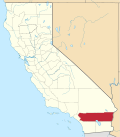This article needs additional citations for verification .(October 2009) |
El Cariso is an unincorporated community in Riverside County, California. It lies along the Ortega Highway, just west of where it crosses the crest of the Santa Ana Mountains a few miles southwest of Lake Elsinore. It lies within the Trabuco District of the Cleveland National Forest. El Cariso Campground is north of the town across the highway from the El Cariso Fire Station.
